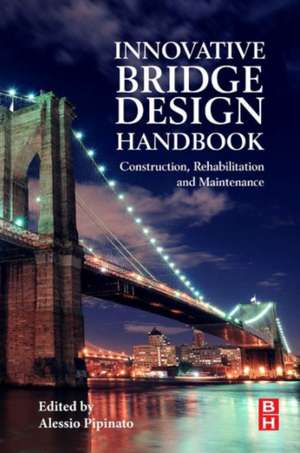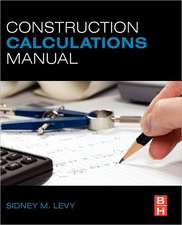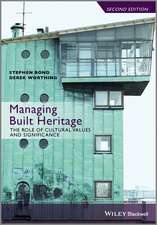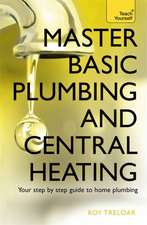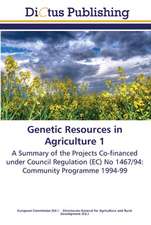Innovative Bridge Design Handbook: Construction, Rehabilitation and Maintenance
Editat de Alessio Pipinatoen Limba Engleză Paperback – 7 feb 2016
The Innovative Bridge Design Handbook: Construction, Rehabilitation, and Maintenance brings together the specific knowledge of a bevy of experts and academics in bridge engineering in the areas of design, assessment, research, and construction. The handbook begins with an analysis of the history and development of bridge aesthetics and design; various types of loads including seismic and wind loads are then described, together with fatigue and fracture. Bridge design based on material such as reinforced concrete, prestressed reinforced concrete, steel and composite, timber, masonry bridges is analyzed and detailed according to international codes and standards. Then bridge design based on geometry, such as arch bridges, girders, cable stayed and suspension bridges, is illustrated. This is followed by a discussion of a number of special topics, including integral, movable, highway and railway bridges, together with seismic component devices, cables, orthotropic decks, foundations, and case studies. Finally, bridge construction equipment, bridge assessment retrofit and management, bridge monitoring, fiber-reinforced polymers to reinforce bridges, bridge collapse issues are covered.
- Loads including seismic and wind loads, fatigue and fracture, local effects
- Structural analysis including numerical methods (FEM), dynamics, risk and reliability, innovative structural typologies
- Bridge design based on material type: RC and PRC, steel and composite, timber and masonry bridges
- Bridge design based on geometry: arch bridges, girders, cable stayed and suspension bridges
- Special topics: integral, movable, highway, railway bridges, seismic component devices, cables, orthotropic decks, foundations
- Construction including construction case studies, construction equipment, bridge assessment, bridge management, retrofit and strengthening, monitoring procedures
| Toate formatele și edițiile | Preț | Express |
|---|---|---|
| Paperback (2) | 659.14 lei 5-7 săpt. | |
| ELSEVIER SCIENCE – 7 feb 2016 | 659.14 lei 5-7 săpt. | |
| ELSEVIER SCIENCE – 8 sep 2021 | 904.39 lei 5-7 săpt. | +112.60 lei 7-13 zile |
Preț: 659.14 lei
Preț vechi: 805.69 lei
-18% Nou
126.14€ • 131.53$ • 104.84£
Carte tipărită la comandă
Livrare economică 13-27 martie
Specificații
ISBN-10: 0128000589
Pagini: 878
Ilustrații: 300
Dimensiuni: 152 x 229 x 41 mm
Greutate: 1.38 kg
Editura: ELSEVIER SCIENCE
Public țintă
Structural/civil engineers and DesignersCuprins
Chapter1 The history, aesthetics, and design of bridges
Section II Loads on bridges
Chapter 2 Loads on bridges
Chapter 3 Wind loads
Chapter 4 Fatigue and fracture
Section III Structural analysis
Chapter 5 Bridge structural theory and modeling
Chapter 6 Dynamics of bridge structures
Chapter 7 Risk and reliability in bridges
Chapter 8 Innovative structural typologies
Section IV Bridge design based on construction material type
Chapter 9 Reinforced and prestressed concrete bridges
Chapter 10 Steel and composite bridges
Chapter 11 Timber bridges
Chapter 12 Masonry bridges
Section V Bridge design based on geometry
Chapter 13 Arch bridges
Chapter 14 Girders
Chapter 15 Long-span bridges
Section VI Special topics
Chapter 16 Integral bridges
Chapter 17 Movable bridges
Chapter 18 Highway bridges
Chapter 19 Railway bridges
Section VII Bridge components
Chapter 20 Seismic component devices
Chapter 21 Cables
Chapter 22 Orthotropic steel decks
Chapter 23 Bridge foundations
Section VIII Bridge construction
Chapter 24 Case study: the Reno bridge
Chapter 25 Case study: the Russky bridge
Chapter 26 Case study: the Akashi-Kaikyo bridge
Chapter 27 Bridge construction equipment
Section IX: Assessment, managment, retrofit, monitoring and rehabilitation of existing bridges
Chapter 28 Bridge assessment, retrofit, and management
Chapter 29 Bridge monitoring
Chapter 30 Application of fiber-reinforced polymers to reinforced concrete bridges
Chapter 31 Bridge collapse
Descriere
Innovative Bridge Design Handbook: Construction, Rehabilitation, and Maintenance, Second Edition, brings together the essentials of bridge engineering across design, assessment, research and construction. Written by an international group of experts, each chapter is divided into two parts: the first covers design issues, while the second presents current research into the innovative design approaches used across the world.
This new edition includes new topics such as foot bridges, new materials in bridge engineering and soil-foundation structure interaction. All chapters have been updated to include the latest concepts in design, construction, and maintenance to reduce project cost, increase structural safety, and maximize durability. Code and standard references have been updated.
- Completely revised and updated with the latest in bridge engineering and design
- Provides detailed design procedures for specific bridges with solved examples
- Presents structural analysis including numerical methods (FEM), dynamics, risk and reliability, and innovative structural typologies
